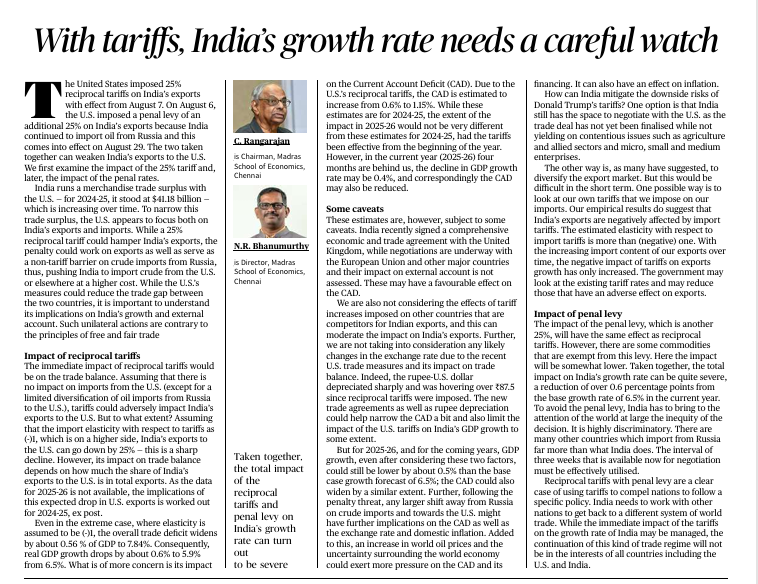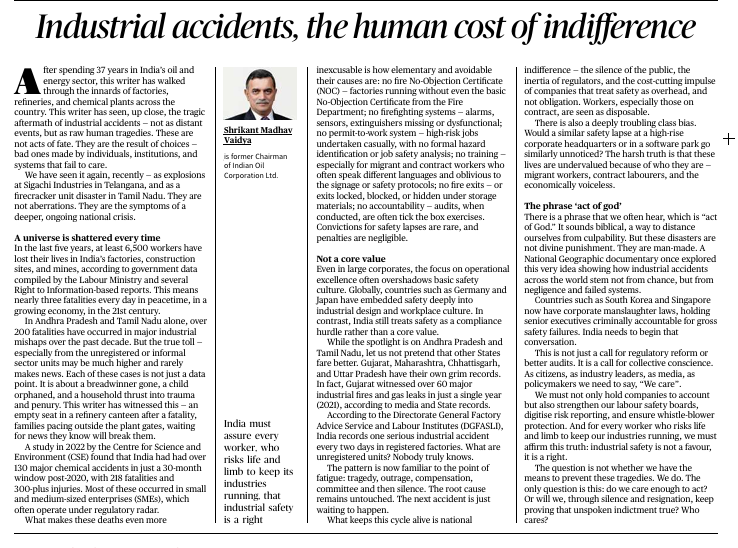Key Points
1. Context
- US Tariff Actions:
- Aug 7: US imposed 25% reciprocal tariffs on Indian exports.
- Aug 6: US imposed an additional 25% penal levy on Indian exports for continuing imports from Russia (effective Aug 29).
- Aug 7: US imposed 25% reciprocal tariffs on Indian exports.
- These combined measures can weaken Indian exports to the US.
2. India–US Trade Background
- India has a merchandise trade surplus with the US ($41.5 billion in 2024–25).
- US aims to reduce the surplus by targeting both Indian exports and imports.
- Reciprocal tariff: 25% on Indian goods.
- Penal levy: 25% on imports from India for continued trade with Russia.
3. Impact of Reciprocal Tariffs
- Immediate impact on trade balance depends on:
- Elasticity of Indian exports to tariffs (low elasticity = less impact).
- Diversification possibilities for affected goods.
- Elasticity of Indian exports to tariffs (low elasticity = less impact).
- Estimated: 0.2–0.5% reduction in India’s exports, lowering GDP growth by ~0.1–0.2% for 2024–25.
- Could widen the Current Account Deficit (CAD) by ~0.1% of GDP.
4. Caveats in Estimates
- Ongoing trade negotiations with the UK, EU, and other countries could mitigate effects.
- Competitor countries’ exports to the US might also face tariffs, lessening India’s disadvantage.
- The exchange rate impact (possible rupee depreciation) could improve export competitiveness.
5. Impact of Penal Levy
- Larger potential hit due to high-value exports affected (e.g., refined petroleum products).
- Estimated GDP growth reduction of ~0.6% from the base projection of 6.5%.
- Penal levy viewed as discriminatory, targeting India for political reasons related to Russia trade.
- May force India to adjust its import sources and re-strategize exports.
6. Policy Suggestions
- Consider reciprocal tariffs against US goods to balance negotiations.
- Diversify export destinations and reduce over-reliance on US market.
- Engage in active diplomatic and trade talks to resolve disputes before the 2025–26 period.
Possible UPSC Mains Questions
GS Paper 3 – Economy & Trade
“Examine the likely macroeconomic impact of recent US tariff measures on India’s exports and GDP growth. Suggest policy responses to mitigate adverse effects.”
Key Points
1. Context & Core Message
- The writer, with decades of experience in India’s oil and energy sector, highlights the avoidable nature of most industrial accidents.
- Industrial accidents are not acts of fate but the result of poor decisions, institutional failures, and systemic negligence.
2. Scale of the Problem
- In the last five years, ~6,000 workers have lost their lives in industrial, construction, and mining accidents (Labour Ministry data).
- Andhra Pradesh & Tamil Nadu alone have seen ~200 fatalities in major industrial mishaps in the past decade.
- India reported 130 major chemical accidents in just a 30-month period (2020–2022).
- Small and medium-sized enterprises (SMEs) are disproportionately affected.
3. Common Causes of Accidents
- Lack of No-Objection Certificates (NOC) from Fire Departments.
- Missing or dysfunctional safety systems – alarms, sprinklers, exit routes, and permit-to-work systems.
- High-risk jobs undertaken without formal hazard identification or safety analysis.
- Minimal safety training, especially for migrant and contract workers.
- Poor accountability — audits either absent or ineffective, and rare convictions for safety lapses.
4. Corporate and Policy Gaps
- In many corporations, operational excellence takes precedence over safety culture.
- Countries like Germany and Japan integrate safety deeply into industrial culture, but India often treats compliance as a box-ticking exercise rather than a genuine safety commitment.
- Poor enforcement of safety laws, especially in states with heavy industrial activity (e.g., Gujarat, Maharashtra, Andhra Pradesh, Chhattisgarh).
5. Social Attitudes & Marginalisation
- Safety negligence often tied to social invisibility of victims — migrant labourers, contract workers, and the economically vulnerable.
- “Act of God” label used to avoid accountability.
- Public indifference and weak regulatory oversight reinforce the cycle of neglect.
6. Recommendations
- Recognise industrial safety as a right and a moral duty.
- Enforce stricter penalties for violations.
- Publicly hold corporations and leaders accountable for preventable accidents.
- Adopt best practices from countries with strong safety cultures (e.g., Singapore, South Korea).
- Strengthen inspection systems and empower workers to raise safety concerns without fear.
Possible UPSC Mains Questions
- GS Paper 3 – Disaster Management / Industrial Safety
“Industrial accidents in India are more a failure of governance than of technology. Discuss with reference to recent incidents and suggest reforms.”



